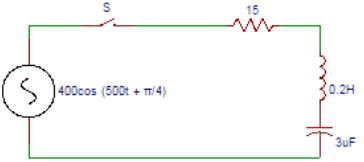This set of Network Theory Multiple Choice Questions & Answers (MCQs) focuses on “Sinusoidal Response of an R-L-C Circuit”.
1. The particular current obtained from the solution of i in the sinusoidal response of R-L-C circuit is?
a) ip = V/√(R2+(1/ωC+ωL)2) cos(ωt+θ+tan-1)((1/ωC+ωL)/R))
b) ip = V/√(R2+(1/ωC-ωL)2) cos(ωt+θ+tan-1)((1/ωC-ωL)/R))
c) ip = V/√(R2+(1/ωC+ωL)2) cos(ωt+θ+tan-1)((1/ωC-ωL)/R))
d) ip = V/√(R2+(1/ωC-ωL)2) cos(ωt+θ+tan-1)((1/ωC+ωL)/R))
View Answer
Explanation: The characteristic equation consists of two parts, viz. complementary function and particular integral. The particular integral is ip = V/√(R2+(1/ωC-ωL)2) cos(ωt+θ+tan-1)((1/ωC-ωL)/R)).
2. In the sinusoidal response of R-L-C circuit, the complementary function of the solution of i is?
a) ic = c1 e(K1+K2)t + c1 e(K1-K2)t
b) ic = c1 e(K1-K2)t + c1 e(K1-K2)t
c) ic = c1 e(K1+K2)t + c1 e(K2-K1)t
d) ic = c1 e(K1+K2)t + c1 e(K1+K2)t
View Answer
Explanation: From the R-L circuit, we get the characteristic equation as
(D2+R/L D+1/LC)=0. The complementary function of the solution i is ic = c1 e(K1+K2)t + c1 e(K1-K2)t.
3. The complete solution of the current in the sinusoidal response of R-L-C circuit is?
a) i = c1 e(K1+K2)t + c1 e(K1-K2)t – V/√(R2+(1/ωC-ωL)2) cos(ωt+θ+tan-1)((1/ωC-ωL)/R))
b) i = c1 e(K1+K2)t + c1 e(K1-K2)t – V/√(R2+(1/ωC-ωL)2) cos(ωt+θ-tan-1)((1/ωC-ωL)/R))
c) i = c1 e(K1+K2)t + c1 e(K1-K2)t + V/√(R2+(1/ωC-ωL)2) cos(ωt+θ+tan-1)((1/ωC-ωL)/R))
d) i = c1 e(K1+K2)t + c1 e(K1-K2)t + V/√(R2+(1/ωC-ωL)2) cos(ωt+θ-tan-1)((1/ωC-ωL)/R))
View Answer
Explanation: The complete solution for the current becomes i = c1 e(K1+K2)t + c1 e(K1-K2)t + V/√(R2+(1/ωC-ωL)2) cos(ωt+θ+tan-1)((1/ωC-ωL)/R)).
4. In the circuit shown below, the switch is closed at t = 0. Applied voltage is v (t) = 400cos (500t + π/4). Resistance R = 15Ω, inductance L = 0.2H and capacitance = 3 µF. Find the roots of the characteristic equation.

a) -38.5±j1290
b) 38.5±j1290
c) 37.5±j1290
d) -37.5±j1290
View Answer
Explanation: By applying Kirchhoff’s voltage law to the circuit,
On differentiating the above equation and on solving, we get roots of the characteristic equation as -37.5±j1290.
5. In the circuit shown below, the switch is closed at t = 0. Applied voltage is v (t) = 400cos (500t + π/4). Resistance R = 15Ω, inductance L = 0.2H and capacitance = 3 µF. Find the complementary current.

a) ic = e-37.5t(c1cos1290t + c2sin1290t)
b) ic = e-37.5t(c1cos1290t – c2sin1290t)
c) ic = e37.5t(c1cos1290t – c2sin1290t)
d) ic = e37.5t(c1cos1290t + c2sin1290t)
View Answer
Explanation: The roots of the charactesistic equation are D1 = -37.5+j1290 and D2 = -37.5-j1290. The complementary current obtained is ic = e-37.5t(c1cos1290t + c2sin1290t).
6. In the circuit shown below, the switch is closed at t = 0. Applied voltage is v (t) = 400cos (500t + π/4). Resistance R = 15Ω, inductance L = 0.2H and capacitance = 3 µF. Find the particular solution.

a) ip = 0.6cos(500t + π/4 + 88.5⁰)
b) ip = 0.6cos(500t + π/4 + 89.5⁰)
c) ip = 0.7cos(500t + π/4 + 89.5⁰)
d) ip = 0.7cos(500t + π/4 + 88.5⁰)
View Answer
Explanation: Particular solution is ip = V/√(R2+(1/ωC-ωL)2) cos(ωt+θ+tan-1)((1/ωC-ωL)/R)). ip = 0.7cos(500t + π/4 + 88.5⁰).
7. In the circuit shown below, the switch is closed at t = 0. Applied voltage is v (t) = 400cos (500t + π/4). Resistance R = 15Ω, inductance L = 0.2H and capacitance = 3 µF. Find the complete solution of current.

a) i = e-37.5t(c1cos1290t + c2sin1290t) + 0.7cos(500t + π/4 + 88.5⁰)
b) i = e-37.5t(c1cos1290t + c2sin1290t) + 0.7cos(500t – π/4 + 88.5⁰)
c) i = e-37.5t(c1cos1290t + c2sin1290t) – 0.7cos(500t – π/4 + 88.5⁰)
d) i = e-37.5t(c1cos1290t + c2sin1290t) – 0.7cos(500t + π/4 + 88.5⁰)
View Answer
Explanation: The complete solution is the sum of the complementary function and the particular integral. So i = e-37.5t(c1cos1290t + c2sin1290t) + 0.7cos(500t + π/4 + 88.5⁰).
8. The value of the c1 in the following equation is?
i = e-37.5t(c1cos1290t + c2sin1290t) + 0.7cos(500t + π/4 + 88.5⁰).
a) -0.5
b) 0.5
c) 0.6
d) -0.6
View Answer
Explanation: At t = 0 that is initially the current flowing through the circuit is zero that is i = 0. So, c1 = -0.71cos (133.5⁰) = 0.49.
9. The value of the c2 in the following equation is?
i = e-37.5t(c1cos1290t + c2sin1290t) + 0.7cos(500t + π/4 + 88.5⁰).
a) 2.3
b) -2.3
c) 1.3
d) -1.3
View Answer
Explanation: Differentiating the current equation, we have di/dt = e-37.5t (-1290c1sin1290t + 1290c2cos1290t) – 37.5e-37.5t(c1cos1290t+c2sin1290t) – 0.71x500sin(500t+45o+88.5o). At t = 0, di/dt = 1414. On solving, we get c2 = 1.31.
10. The complete solution of current obtained by substituting the values of c1 and c2 in the following equation is?
i = e-37.5t(c1cos1290t + c2sin1290t) + 0.7cos(500t + π/4 + 88.5⁰).
a) i = e-37.5t(0.49cos1290t – 1.3sin1290t) + 0.7cos(500t + 133.5⁰)
b) i = e-37.5t(0.49cos1290t – 1.3sin1290t) – 0.7cos(500t + 133.5⁰)
c) i = e-37.5t(0.49cos1290t + 1.3sin1290t) – 0.7cos(500t + 133.5⁰)
d) i = e-37.5t(0.49cos1290t + 1.3sin1290t) + 0.7cos(500t + 133.5⁰)
View Answer
Explanation: The complete solution is the sum of the complementary function and the particular integral. So i = e-37.5t(0.49cos1290t + 1.3sin1290t) + 0.7cos(500t + 133.5⁰).
Sanfoundry Global Education & Learning Series – Network Theory.
To practice all areas of Network Theory, here is complete set of 1000+ Multiple Choice Questions and Answers.
If you find a mistake in question / option / answer, kindly take a screenshot and email to [email protected]
- Apply for Electrical Engineering Internship
- Practice Electronics & Communication Engineering MCQs
- Check Electrical Engineering Books
- Check Network Theory Books
- Practice Electrical Engineering MCQs
